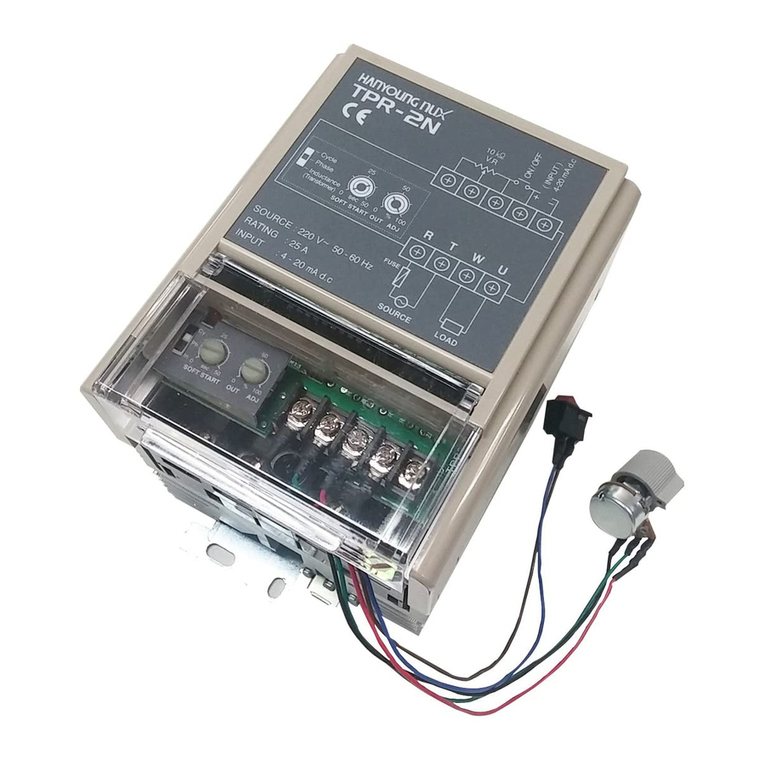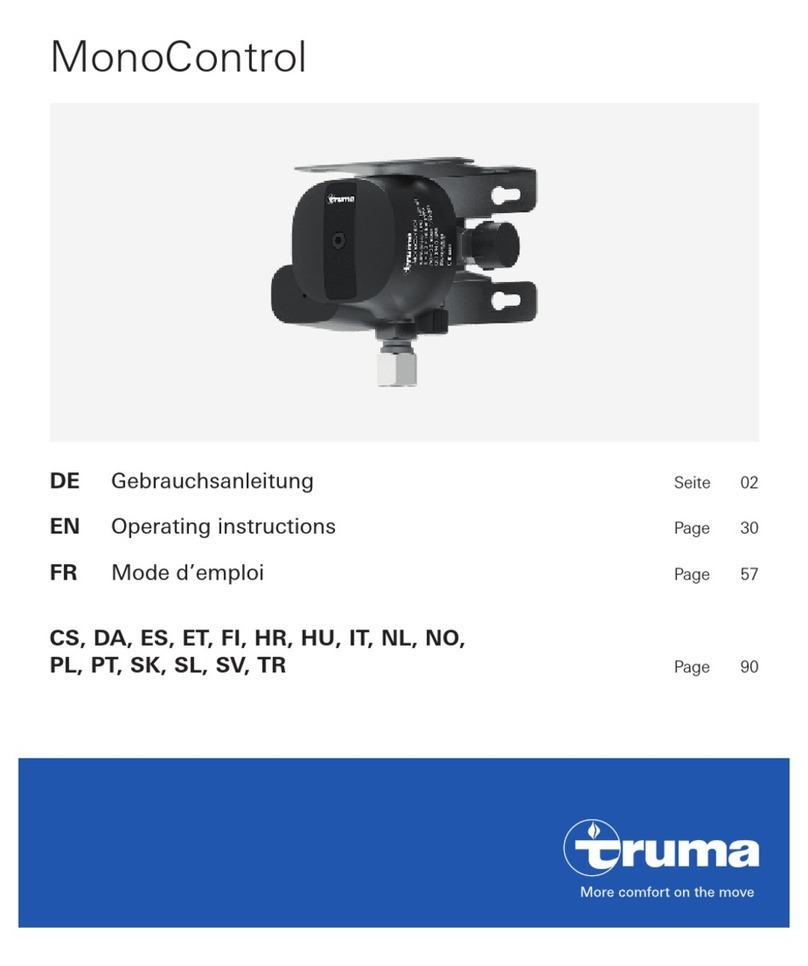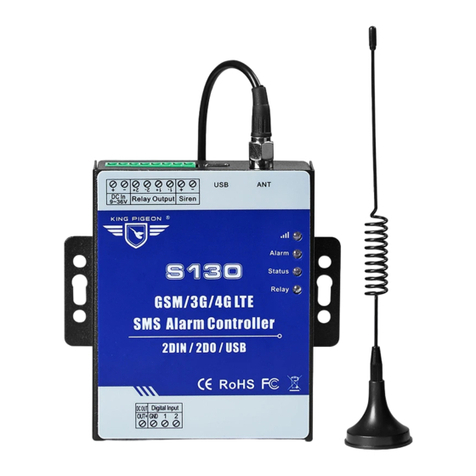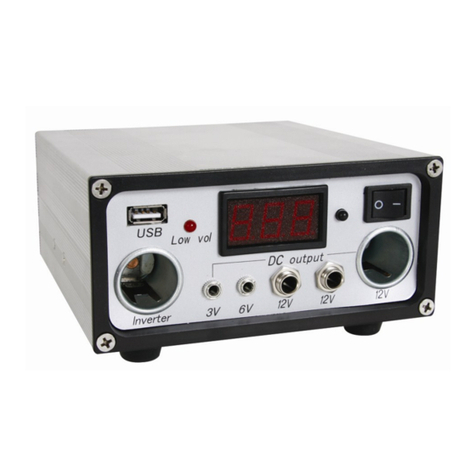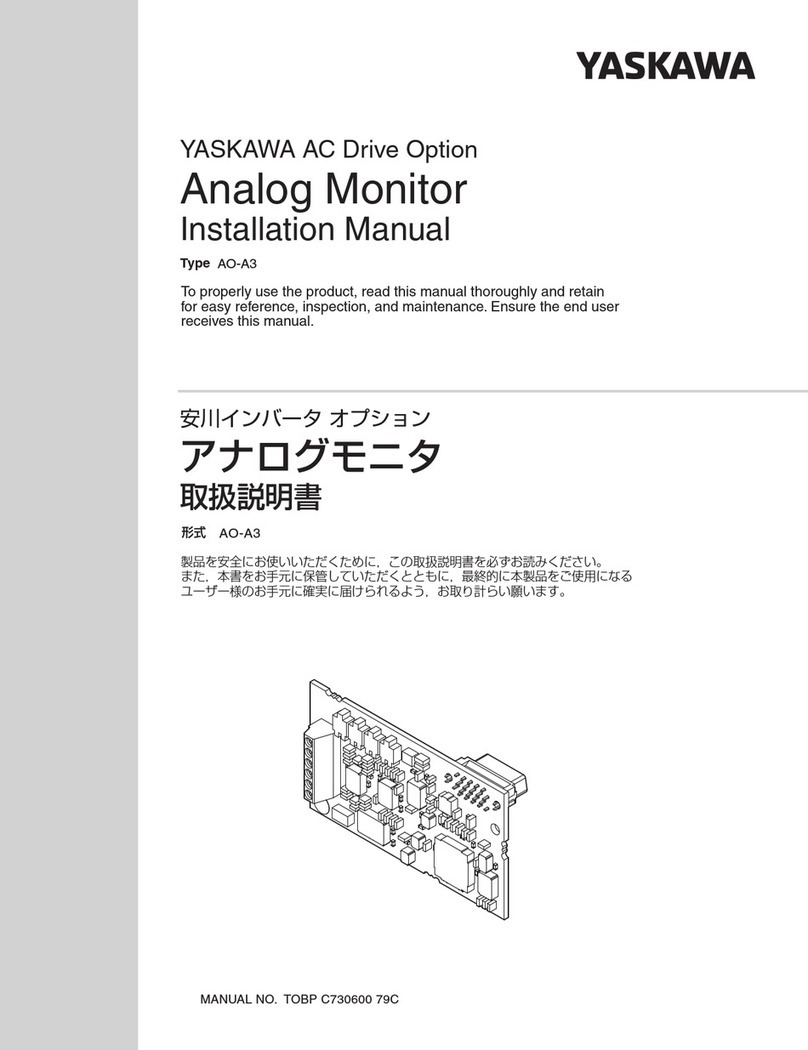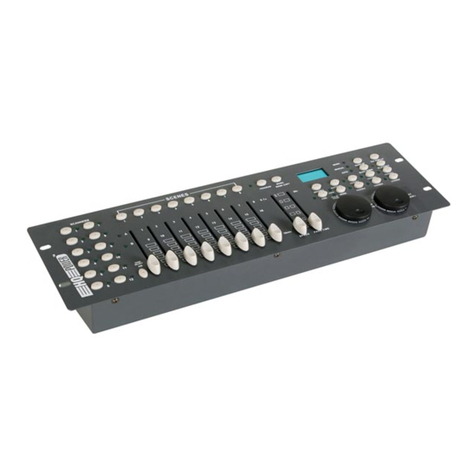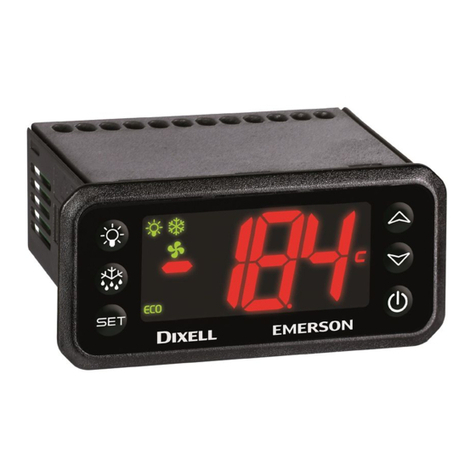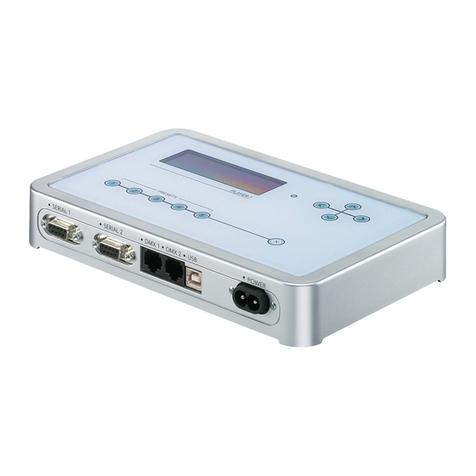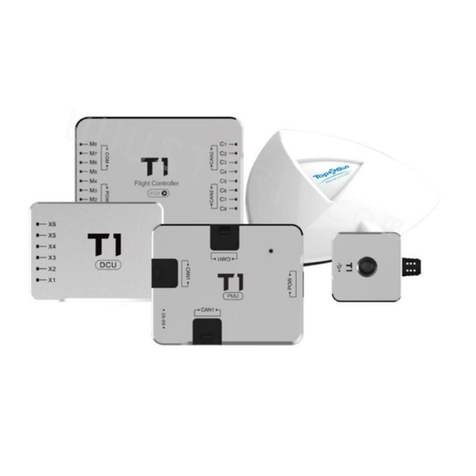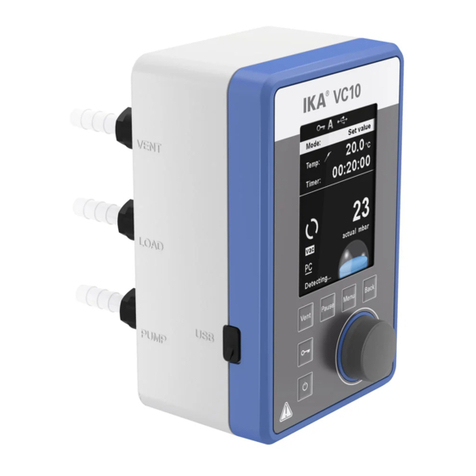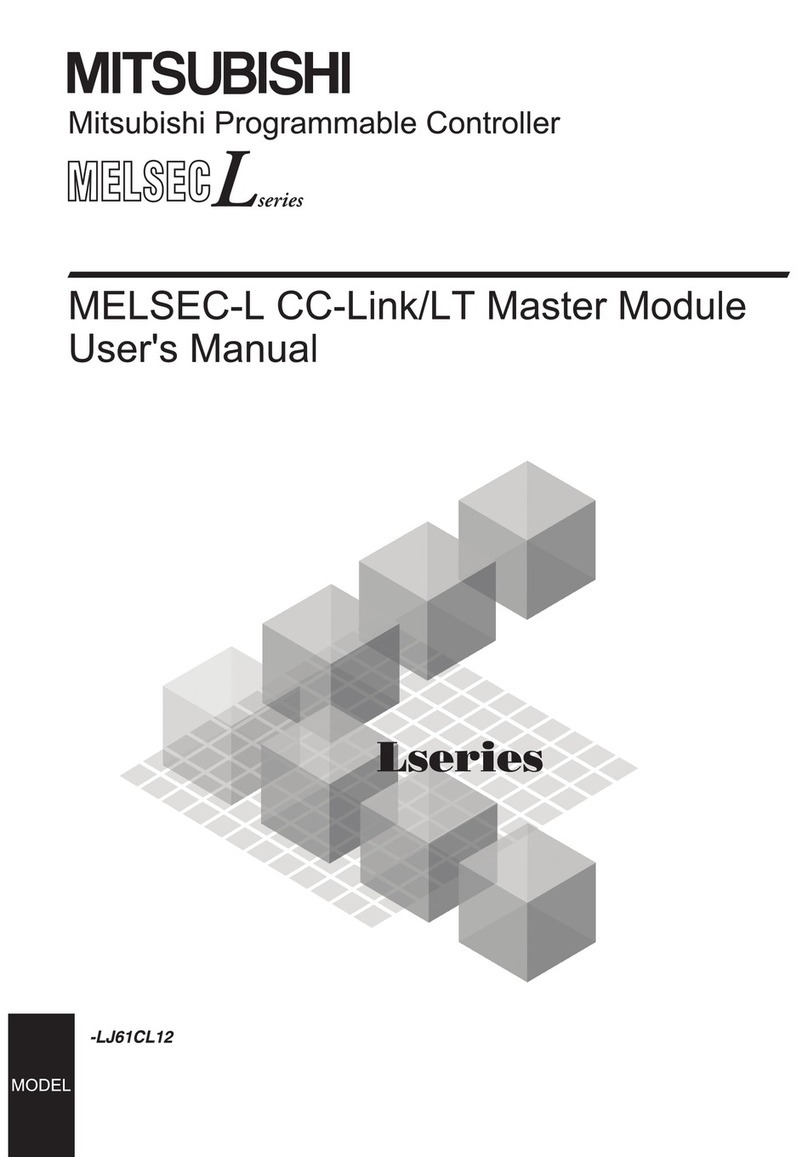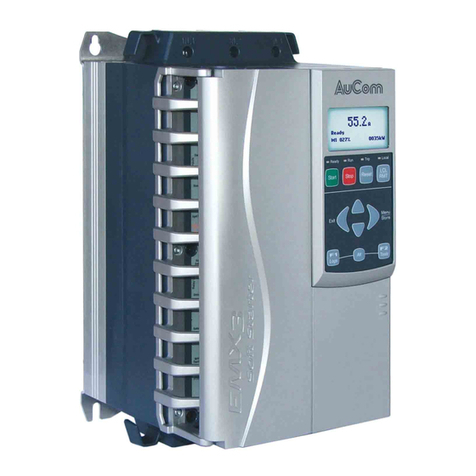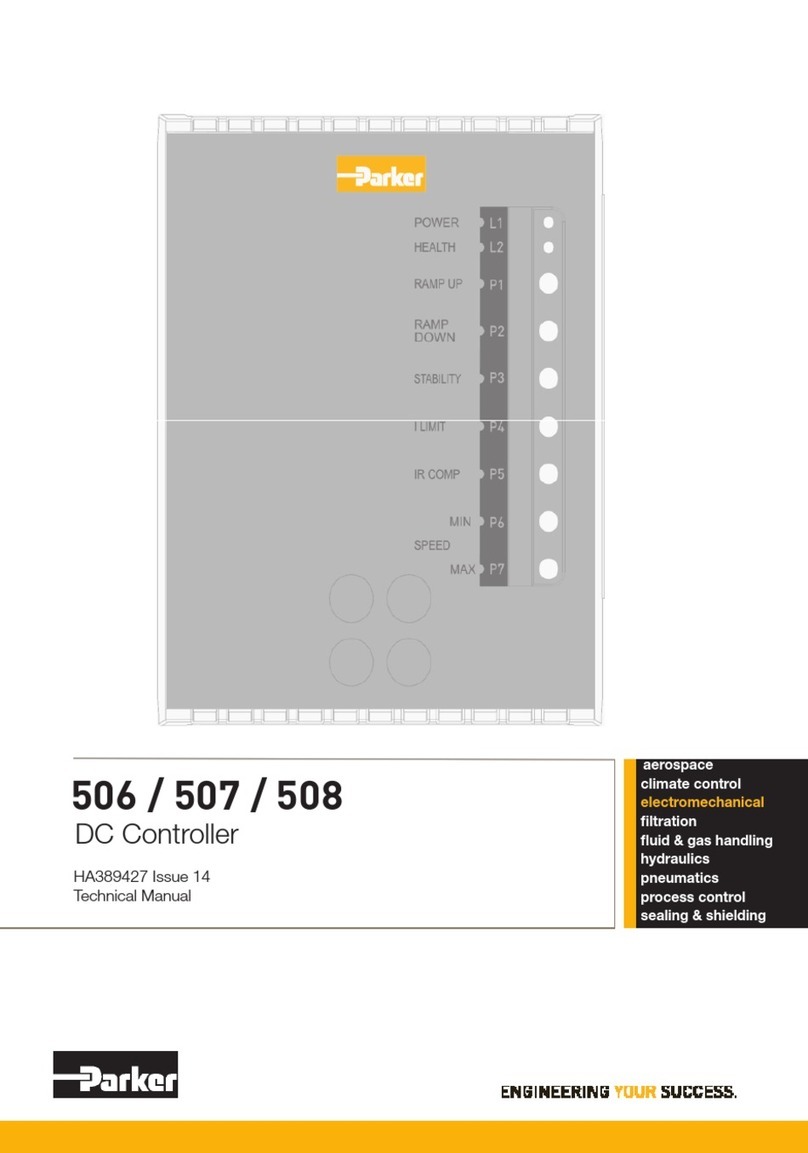INDELAC CONTROLS SNS20 Instruction manual

Safe & Secure Series Electric Actuator
with Internal Battery Back-up
Installation, Operation &
Maintenance Manual
For Use with:
SNS20 & SNS28 Models (R1)
Additional supplements may be needed for selected optional equipment including, but not
limited to models with: modulating controls, timers, speed controllers &remote/off/local
controls.
TELEPHONE: +1-859-727-7890
TOLL FREE: +1-800-662-9424
FAX: +1-859-727-4070
SHIPPING ADDRESS: 6810 POWERLINE DR.-FLORENCE, KY. 41042
For a digital copy of this manual, access to training videos, access to 3D product renderings,
or to request additional support
VISIT OUR WEBSITE AT WWW.INDELAC.COM
REVISED: FEB 2021

SNS20-28C Actuator with Internal Battery Back-up Installation, Operation & Maintenance Manual
Page 2
INTRODUCTION:
Thank you for selecting Indelac Controls, Inc. (ICI) for your valve or damper automation
requirement. We at ICI are proud of our products and feel confident they will meet or
exceed your expectations of quality and reliability.
Every precaution has been taken to insure that your equipment will arrive undamaged;
however, accidents do occur. Therefore, the first thing you must do upon receipt of your
package is to inspect it for damage. If the box is damaged there is a possibility that the
equipment inside the box may be damaged as well. If this is the case YOU MUST FILE A
CLAIM with the delivering CARRIER. All shipments are F.O.B. our factory and it is YOUR
RESPONSIBILITY to file a claim for damages.
STORAGE:
If the actuators are scheduled for installation at a later date:
1. Store off the floor.
2. Store in a climate controlled building.
3. Store in a clean and dry area.
FOR FUTURE REFERENCE RECORD:
1. Actuator model number
2. Actuator enclosure type NEMA 4 , NEMA 4X _, NEMA 7 _, NEMA 4 & 7__
3. Actuator output torque LB-IN
4. Motor characteristics, Voltage Hertz Phase
5. Actuator serial number
6. Date of installation Put into operation
7. Valve Data:
7a. Manufacturer
7b. Style & fig. No.
7c. Size
7d. End connection
7e. Material of construction, Body Stem & ball
7f. Brake away torque LB-IN @ PSI
7g. Other helpful data
MEDIA:
1. System media
2. Temperature, (deg. F.) Maximum, . Minimum, .
3. Pressure PSI
*As this information is listed it is important to pay attention to all of the actuator specifications
relative to the valve specifications and system requirements. If the actuator is not properly sized
for the valve and application the life will be shortened or it may not work at all.

SNS20-28C Actuator with Internal Battery Back-up Installation, Operation & Maintenance Manual
Page 3
TOOLS REQUIRED:
ADDITIONAL TOOLS WILL BE REQUIRED FOR THE SCREWS TO MOUNT THE VALVE TO THE ACTUATOR.
SNS20C & SNS28C SERIES
Cover Screws 7/16” Socket
Terminal Strip Screws 3/16” Wide Flat Head Screwdriver
Cam Set Screw 5/64” Allen Wrench
Mounting Pad Screws 9/16” Socket
SUGGESTED MAXIMUM TORQUE VALUES FOR FASTENERS (IN-LBS.)
SCREW SIZE LOW CARBON STEEL 18-8 SS 316 SS ALUMINUM
2-56 2.2 2.5 2.6 1.4
4-40 4.7 5.2 5.5 2.9
6-32 9 10 10 5
8-32 18 20 21 10
10-24 21 23 24 13
10.32 30 32 33 19
¼-20 65 75 79 45
5/16-18 129 132 138 80
3/8-16 212 236 247 143
½-13 465 517 542 313
5/8-11 1000 1110 1160 715

SNS20-28C Actuator with Internal Battery Back-up Installation, Operation & Maintenance Manual
Page 4
PRODUCT DESCRIPTION:
The SNS20 – 28C Safe & Secure Series Actuator is a quarter turn Open/Close Actuator with Battery
Backup Power – ALL IN ONE! No more mounting a separate Fail Safe Unit to provide power in case of
external power failure. The actuator’s internal battery will provide power to the motor in the event of an
external power failure. The actuator can be configured in the field for FAIL OPEN or FAIL CLOSE.
This new series of actuator can operate loads from 2000 in/lbs. to 2800 in/lbs. These actuators can be
ordered to operate on input voltages of 115vac/230vac, 24vac/24vdc or 12vdc and are enclosed in a
SINGLE standard “L” series NEMA 7 style housing.
Switching from external power to battery power is seamless – when the external power source fails, the
internal transfer circuit switches to battery power automatically without any operator intervention.
Depending on the fail position setting that the operator has pre-selected for the actuator, the actuator will
drive the valve to that position. Once the external power is restored, the actuator will automatically switch
back to external power, and the battery will begin to re-charge automatically! The actuator will then return
to its last position before the power had failed.
This unit is available as a Standard OPEN/CLOSE Actuator or with the Modulating Option for precise valve
position control using 4-20mA, 0-10V or 1-5V external input signal. Position feedback is available for both
the standard and the modulating models.
A variety of other optional features are available for these actuators including but not limited to: Aux. Limit
Switches, Motor Brakes, Additional Conduit Entries, Mechanical Stops, Temperature and Condensation
Controls. Speed Controls & Timers are available mounted in a separate enclosure.
UNIT SPECIFICATIONS:
Enclosure rating: NEMA 4 Standard; NEMA 4X & NEMA 7 also available
Motor Duty Cycle: 100% Standard
Weight: 40 Lbs.
Mounting Pad: ISO 5211 F10 BC 4.015”
Operating Voltages: 115vac/230vac, 24vac/24vdc, 12vdc
Incoming Power Fuse: TR5 Pico Fuse, 250V / 10A
Motor Fuse: 10A Glass Cartridge, Slow Blow 5x20mm
Power: 120 Watts Max. / add 20 Watts for optional heater
Position Indication: Dome Style Visual Indicator
Battery: 12vdc, 1.4AHr
Battery Recharge Time: Approximately 8-10 Hours
Battery Life on Trickle Charge: 4-5 years
Auxiliary Switch Rating: Dry Contact, 15 Amps @ 250vac
Input Signal Contact Rating: Internally Generated – (12vdc @ 1A)
Temperature Range: -40°F to 150°F
Heater and Thermostat required below 0°F

SNS20-28C Actuator with Internal Battery Back-up Installation, Operation & Maintenance Manual
Page 5
MECHANICAL MOUNTING:
The Safe & Secure Actuator can be direct mounted to any valve using the standard ISO 5211 F10
Output. See the drawing below for the actuator output mounting dimensions for valves requiring
mounting hardware.

SNS20-28C Actuator with Internal Battery Back-up Installation, Operation & Maintenance Manual
Page 6
CUSTOMER ELECTRICAL CONNECTIONS FOR STANDARD OPEN/CLOSE:
All customer electrical connections are done per the below wiring diagrams. Incoming power
should be wired using 12awg minimum for DC and 18awg for AC. Control signal wiring may be
22awg or larger for direction control. All wiring is to be completed through the conduit opening
using the appropriate conduit –Refer to your local electrical codes. Remove the actuator cover
by loosening the cover screws and pulling straight up on the cover to complete the wiring and set-
up. Connect the Main Power to the actuator per the appropriate wiring diagram below. Assure
that the power wires are DE-ENERGIZED!
WIRING DIAGRAM: W200708
200708
DESCRIPTION: 115VAC/230VAC SNS2000 ACTUATOR STANDARD OPEN/CLOSE
OPTIONS SHOWN:
OPTIONS SHOWN:
OPTIONS SHOWN:
2 AUXILIARY SWITCHES
MOTOR BRAKE
HEATER AND THERMOSTAT
WARNING!
PAY CLOSE ATTENTION TO THE WIRING DIAGRAMS WHEN CONNECTING THE INPUT POWER TO THE ACTUATOR.
IMPROPER POWER CONNECTION CAN RESULT IN DAMAGE TO THE ACTUATOR OR SERIOUS INJURY TO THE INSTALLER.

SNS20-28C Actuator with Internal Battery Back-up Installation, Operation & Maintenance Manual
Page 7
CUSTOMER ELECTRICAL CONNECTIONS FOR STANDARD OPEN/CLOSE:
WIRING DIAGRAM: W200628
200628
DESCRIPTION: 24VAC & 24VDC SNS2000 ACTUATOR STANDARD OPEN/CLOSE
OPTIONS SHOWN:
OPTIONS SHOWN:
OPTIONS SHOWN:
2 AUXILIARY SWITCHES
MOTOR BRAKE
HEATER AND THERMOSTAT
NOTE: For all wiring, make sure the connectors and wires are fully seated after making all wiring
connections.

SNS20-28C Actuator with Internal Battery Back-up Installation, Operation & Maintenance Manual
Page 8
CUSTOMER ELECTRICAL CONNECTIONS FOR STANDARD OPEN/CLOSE:
WIRING DIAGRAM: W200707
200707
DESCRIPTION: 12VDC SNS2000 ACTUATOR STANDARD OPEN/CLOSE
OPTIONS SHOWN:
OPTIONS SHOWN:
OPTIONS SHOWN:
2 AUXILIARY SWITCHES
MOTOR BRAKE
HEATER AND THERMOSTAT
Customer Connections, Board Connector View
Extra Connections
–Relays and Status
Power & Signal Connections
–
AC/DC Inputs & Open/Close

SNS20-28C Actuator with Internal Battery Back-up Installation, Operation & Maintenance Manual
Page 9
CUSTOMER ELECTRICAL CONNECTIONS FOR MODULATING OPTION:
WIRING DIAGRAM: W200620
200620
DESCRIPTION: 115/230VAC ACTUATOR WITH MODULATING CONTROL
OPTIONS SHOWN:
OPTIONS SHOWN:
OPTIONS SHOWN:
2 AUXILIARY SWITCHES
MOTOR BRAKE
HEATER AND THERMOSTAT

SNS20-28C Actuator with Internal Battery Back-up Installation, Operation & Maintenance Manual
Page 10
CUSTOMER ELECTRICAL CONNECTIONS FOR MODULATING OPTION:
WIRING DIAGRAM: W200629
200629
DESCRIPTION: 24VAC & 24VDC ACTUATOR WITH MODULATING CONTROL
OPTIONS SHOWN:
OPTIONS SHOWN:
OPTIONS SHOWN:
2 AUXILIARY SWITCHES
MOTOR BRAKE
HEATER AND THERMOSTAT

SNS20-28C Actuator with Internal Battery Back-up Installation, Operation & Maintenance Manual
Page 11
CUSTOMER ELECTRICAL CONNECTIONS FOR MODULATING OPTION:
WIRING DIAGRAM: W200630
630
DESCRIPTION: 12VDC ACTUATOR WITH MODULATING CONTROL
OPTIONS SHOWN:
OPTIONS SHOWN:
OPTIONS SHOWN:
2 AUXILIARY SWITCHES
MOTOR BRAKE
HEATER AND THERMOSTAT

SNS20-28C Actuator with Internal Battery Back-up Installation, Operation & Maintenance Manual
Page 12
ACTUATOR SET-UP FOR STANDARD OPEN/CLOSE ACTUATOR:
After the actuator is mounted mechanically to the valve and the external electrical wiring is
complete, the actuator is ready for set up. The actuator cover will need to be removed, if not
already done so.
1) On the circuit board, move the “Fail Switch” to the desired “FAIL” position. The description
of the 2 positions are as follows:
OPEN = ACTUATOR WILL MOVE TO THE OPEN POSITION WHEN POWER FAILS.
CLOSE = ACTUATOR WILL MOVE TO THE CLOSE POSITION WHEN POWER FAILS.
WARNING: DO NOT switch the FAIL switch while the actuator is moving or while the
battery is plugged into the SNS board. Turn OFF power before moving switch!
2) Plug the battery connector into the 2 pin BATTERY header on the SNS Board.
NOTE: If the “Fail Switch” was moved to the “CLOSE” position, the actuator will begin to move to the Close
location since the actuator is shipped in the OPEN Position.
OPEN &
CLOSE LEDs
Fail Switch – Slide to
the desired position
Battery Connector –
Plug the battery
connector into the 2 pin
BATTERY header on
the board.
Battery Status
LEDs

SNS20-28C Actuator with Internal Battery Back-up Installation, Operation & Maintenance Manual
Page 13
Limit Switch CAMs
(Bottom = Close;
Top = Open) – Loosen
the set screw to rotate for
adjustment.
Auxiliary Switches
(if installed)
Battery Mounting
115/230vac Power
Supply
Battery, 1.4AHr
3) Turn on the Main external power to the actuator.
4) Using the external direction control signal, run the actuator open and closed to verify that
the valve is opening and closing fully. If not, the Open and Close CAMs may be adjusted to
allow more or less motion in both directions. The CAM set screw needs to be loosened to
rotate the CAM. Re-tighten the set screw when the desired valve position is achieved.
NOTE: If control signal is provided by a PLC relay, program needs to incorporate a delay between the OPEN &
CLOSE signal.
The external control signal is done using a dry contact switch or relay. DO NOT APPLY a voltage to the OPEN or
CLOSED control signal pins. The voltage is provided on terminal #4 via the SNS control board.
Standard Actuator View of Power Supply

SNS20-28C Actuator with Internal Battery Back-up Installation, Operation & Maintenance Manual
Page 14
ACTUATOR SET-UP FOR MODULATING OPTION ACTUATOR:
After the actuator is mounted mechanically to the valve and the external electrical wiring is
complete, the actuator is ready for set up. The actuator cover will need to be removed, if not
already done.
1) The Safe & Secure board will supply power to the Modulating Controller Board. When the
incoming power to the unit fails, the battery will supply power to the Controller Board and
run the motor to the selected FAIL position.
2) Set the DIP Switch #3 to ON (right) & #4 to OFF (left) on the DMC 102 Controller Board.
This will run the actuator to the CLOSED position in the event of a loss of input control
signal. If it is desired to have the actuator go to the OPEN position when the input signal is
lost, then DIP Switch #3 is set to OFF (left) & #4 is set to ON (right).
**DO NOT CHANGE THESE SWITCH SETTINGS WITH THE POWER ON!!
Green & Red
LEDs – close
and open
indicators
Zero Pot
Span Pot
Configuration
Dip Switches
Modulating
Board, 4-20mA
Limit Switch
CAMs
Power & Signal
Connections –
AC & DC Inputs

SNS20-28C Actuator with Internal Battery Back-up Installation, Operation & Maintenance Manual
Page 15
3) Plug the battery connector onto the 2 pin BATTERY Header on the SNS Board.
4) Turn on the Main external power to the actuator.
5) Apply the input signal (4-20mA, 0-10v, etc.) to run the actuator open and closed to verify
that the valve is opening and closing fully. If not, the ZERO and SPAN pots on the
Modulating Controller Board may be adjusted to allow more or less motion in both
directions.
OPERATION:
Upon applying external supply power to the actuator, the Blue LED on the Safe & Secure Board
should illuminate indicating that the power from the external source is on. When the external
power fails, the Blue LED will turn off and the Yellow Battery LED will illuminate indicating that the
actuator is now running on battery power. When this occurs, the actuator will move to the desired
position (OPEN or CLOSED), as selected by the operator during set-up.
ON:
EXTERNAL
UTILITY POWER IS
CONNECTED & ON
OFF:
EXTERNAL
UTILITY POWER IS
DISCONNECTED
OR TURNED OFF
BLUE
ON:
ACTUATOR IS
RUNNING ON
BATTERY POWER
OFF:
ACTUATOR IS NOT
OPERATING ON
BATTERY POWER
YELLOW ON:
BATTERY IS LOW
RECHARGE OR
REPLACE
OFF:
BATTERY IS
CHARGED
RED
Battery Connector
–
Plug the battery
connector into the
header on the SNS
board.
Extra Connections
–
Relays & Status
SNS-VP Board
1.4AHr Battery

SNS20-28C Actuator with Internal Battery Back-up Installation, Operation & Maintenance Manual
Page 16
For example, if the actuator is moving towards the Open position with the Fail Switch on the SNS
Board set for CLOSED, the actuator will STOP, and move to the Closed position if the external
power should fail.
On the Modulating version,the actuator operates the same as the standard version, except the
FAIL position is set by the DIP Switches on the Modulating Control Board.
On the standard version, when the incoming power fails, the Blue LED on the SNS Board will turn
OFF and the Yellow Battery LED will turn on. Also, the battery status LED (Green or Red) will
illuminate to show the charge level of the battery. If the Green LED is on, the battery is at full
power, but if the Red LED is illuminated, the battery power is low and will need to be charged. If
neither the Green or Red LED is lit under battery power, the battery is completely dead and will
need to be replaced. In this instance, the Yellow LED will not light either.
On the Modulating version, when the incoming power fails, the Blue LED on the SNS Board will
turn OFF and one of the battery status lights will turn ON (Green or Red). There is no Yellow LED
on the Modulating SNS Board.
There is a battery charge circuit built into the Safe & Secure actuator that will charge the battery
when the external power is on. After a full 8-10 hour full charge, the Green battery status LED will
illuminate. If after 8-10 hours of “on board” charging, the Red LED remains on, then the battery
needs to be replaced. If the battery is too low, the actuator will FAIL in place.
The Standard SNS unit will indicate direction of operation (OPEN or CLOSE) by lighting the OPEN
(Green) or CLOSE (Red) LED. If, for instance, an OPEN signal is delivered to the actuator, the
OPEN Green LED should turn on and the actuator should move to the OPEN position. If that
Green LED turns on and the motor does not move, then the Motor Fuse has blown.
The Modulating version SNS will indicate OPEN and CLOSE motion by lighting the Red (OPEN)
and Green (CLOSE) LEDs on the Modulating Control Board, DMC-102.
If the Optional Heater and Thermostat have been installed, the Heater will operate when the
external power supply is on. If the external power supply should fail and the actuator runs on
battery power, the Heater will NOT be operational.
Please see the photos in the previous pages of this manual for the locations of the above
mentioned boards and LED locations.
WARNING: DO NOT CHANGE THE FAIL SWITCH SETTING WITH THE POWER ON!!
POWER OFF FIRST!
WARNING: DO NOT CHANGE THE DIP SWITCH SETTING WITH THE POWER ON!!
POWER OFF FIRST!

SNS20-28C Actuator with Internal Battery Back-up Installation, Operation & Maintenance Manual
Page 17
DUTY CYCLE:
All SNS 2000 Series actuators are rated 100% duty cycle at ambient temperature at rated torque.
MOTOR THERMAL OVER LOAD:
The Safe and Secure series actuator motors are internally fused with a 250v, 10A, 5x20mm glass
cartridge slow blow fuse. When the motor current rises to an overload level, the on-board fuse will
blow and will need to be replaced. The fuse must be replaced with an equivalent fuse to keep
from damaging the system. It is the responsibility of the operator to check the entire system and
clear any jams or valve binding prior to restarting the system.
MECHANICAL OVER LOAD:
Indelac actuators are all designed to withstand stall conditions. It is not recommended to subject
the unit to repeated stall conditions. However, should it occur the actuator would not experience
gear damage.
ORDERING PARTS:
When ordering parts please specify:
Actuator Model Number, Actuator Serial Number, Part Number & Part Description.
RECOMMENDED SPARE PARTS:
#24000-VC CLOSE Switch with wires
#24000-VO OPEN Switch with wires
#32016 Battery, 1.4AHr, 12VDC
#46045 Fuse, 10A, 250V TR5 Round Plug In (Incoming Power)
#46039 Fuse, 10A, 250V 5x20mm Glass Cartridge (Motor Fuse)
AUXILIARY SWITCH CONTACT RATINGS :
The Snap Action Auxiliary Switches are SPDT & the contacts are rated for 15 Amps @ 250 VAC.

SNS20-28C Actuator with Internal Battery Back-up Installation, Operation & Maintenance Manual
Page 18
NEMA 7 ENCLOSURE, GENERAL:
In general, operation and maintenance of a NEMA 7 electric actuator is no different than that of a
NEMA 4 electric actuator. However, there are some precautions that must be followed.
1. DO NOT install in ambient temperatures that exceed 140 degrees F.
2. DO NOT under any circumstances remove the actuator cover while in a hazardous location
when the contacts are still live, this could cause ignition of hazardous atmospheres.
3. DO NOT under any circumstances use a NEMA 7 electric actuator in a hazardous location
that does not meet the specifications for which the actuator was designed. The actuator is
clearly tagged with the NEMA classification it was designed for.
4. DO NOT mount, test and calibrate actuator on valve in non-hazardous location.
5. When removing the cover care must be taken not to scratch, scar or deform the flame path
of the cover or base of the actuator, this will negate the NEMA 7 rating of the enclosure.
6. When replacing the cover on actuators rated NEMA 4 and 7 take care that the gasket is in
place to assure the proper clearance after the cover is secured. After securing the cover
screws check the clearance between the cover and the base - a .002” thick by 1/2” wide
feeler gauge may not enter between the two mating faces more than .125”.
7. All electrical connections must be to state and local codes and in accordance with the
specifications for which the unit is being used.
8. After de-energizing the NEMA 7 actuator, wait at least 45 minutes before removing the
cover to allow the heater to cool.
*After proper installation the actuator will require little or no maintenance. In the event
maintenance is required remove it from the hazardous location before attempting to work on it. If
the actuator is in a critical application and down time is not permitted it is advisable to have a
spare actuator in stock.
MANUAL REVISIONS
JUNE 22,
2018
CHANGED EXTERNAL INDICATOR WIRING CONNECTIONS SECTION – CURRENT LOAD USED TO
BE 5A. NEW RELAYS ON BOARD ARE 2A @ 30VDC AND 0.5A @ 125VAC.
MAY 13,
2020
ADDED ELECTRICAL SPECIFICATIONS FOR AUXILIARY SWITCHES/CONTACT CURRENT;
UPDATED INDELAC LOGO.
FEB 3,
2021
“R1” – NEWLY RE-DESIGNED SNS2000 SERIES W/SMALLER BOARDS AND BATTERY. NEW
BRACKET DESIGNS AND LAYOUT TO FIT ALL INTO SINGLE “L” ACTUATOR ENCLSOURE.

SNS20-28C Actuator with Internal Battery Back-up Installation, Operation & Maintenance Manual
Page 19
TROUBLESHOOTING AND FAQ’S
SYMPTOM PROBLEM SOLUTION
ACTUATOR DOES NOT RESPOND
TO CONTROL SIGNAL. Power not on Turn on power
Actuator wired incorrectly Check wiring diagram & rewire
Wrong voltage Check power supply & make
appropriate changes
Thermal overload activated Check and replace 10A Motor
Fuse –see Part Numbers
Actuator and valve in opposite Remove actuator and rotate 90
positions when actuator was mounted. degrees & remount
Input Power Fuse Blown Replace with proper value fuse
Input signal wires not tight in terminals Tighten terminal block screws
Bad Brake Remove brake hub & try to run
Modulating Signal Not Present Connect 4-20mA or 0-10vdc
Signal to Actuator
ACTUATOR WILL NOT OPEN OR
CLOSE COMPLETELY.Travel limits set wrong Reset cams.
Valve torque too high for actuator Install correct size actuator
Mechanical stops not removed Remove stops, CAUTION: Do
not remove any part required for
proper operation
Modulating Actuator Set Points Adj. Adjust the SPAN or ZERO pots
On the Modulating Board
VALVE OSCILLATES.
Valve torque too high for actuator Install correct size actuator.
Actuator without brake installed on
butterfly valve Install brake
Motor brake out of adjustment. Adjust brake
Set screw loose in brake disc Adjust brake and tighten set-
screw
MOTOR RUNS BUT OUTPUT
SHAFT DOES NOT ROTATE.Gear damage or sheared pin/key Contact ICI or nearest
distributor

SNS20-28C Actuator with Internal Battery Back-up Installation, Operation & Maintenance Manual
Page 20
Battery Condition Test
1) Turn the power to the actuator Off.
2) Install a switch or jumper wire into J12 terminals 4 & 5.
3) Turn the actuator power back On.
4) If using a switch, close the Test Switch.
5) If the Battery Red LED on the Safe and Secure Board illuminates, the battery is low.
6) Turn the power back Off.
7) Remove the jumper or turn off the Test Switch.
8) Apply external power to the actuator and verify that the Blue LED illuminates.
9) Wait 8-10 hours for the battery to fully charge and close the Test Switch again.
10) If the Battery Green LED on the Safe and Secure Board illuminates, the battery is good and
is charged.
11) If the Red LED is comes back on, or is OFF, the battery is bad and needs to be replaced.
Power Test
1) Apply external power to the actuator. The Blue LED should illuminate.
2) If there is no Blue LED, check that the incoming power is connected properly to the
actuator & the breaker is on.
3) Next, verify that the wires are tight in the input connector.
4) If still no Blue LED, check the on board fuse (TR5 style – round) in the Safe & Secure
Board.
5) If the Power Input Fuse is blown, replace the fuse.
6) If the fuse is good, the circuit board is bad and needs to be replaced.
7) On modulating versions, a control input signal (4-20mA or 0-10vdc) needs to be present to
run the actuator.
This manual suits for next models
1
Table of contents
